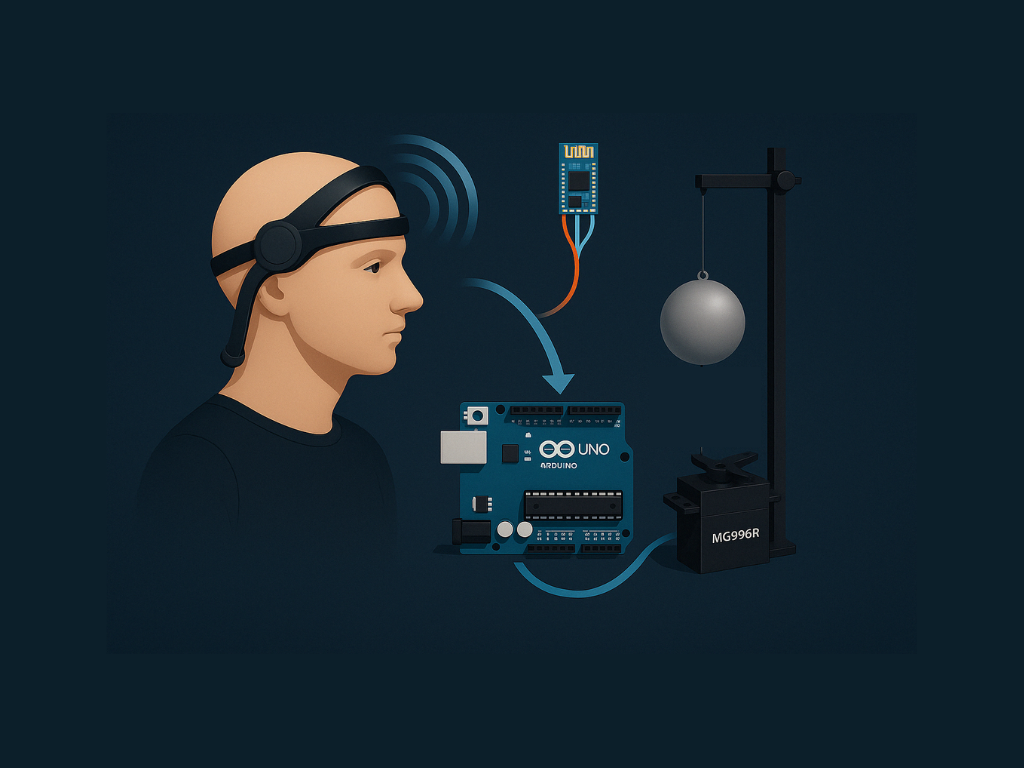Mind Over Matter: Building a Brain-Controlled Telekinesis Simulator

Have you ever watched sci-fi movies where characters move objects with their minds and thought, "I wish I could do that"? Well, I couldn't resist trying to make this a reality. Before I even began my formal software engineering education, I embarked on a journey to create what I call the "Mind Concentration Trainer" - a device that gives you the closest thing to real telekinesis that today's technology allows.
The Power of Thought
The concept is simple but fascinating: use your concentration levels to physically move an object. Thanks to modern EEG technology, we can now read brainwave patterns and translate them into actions in the physical world.
When I first successfully made a metal ball rise simply by focusing my thoughts, the feeling was indescribable. There I was, sitting perfectly still, concentrating deeply, watching as an object responded to nothing but the electrical activity in my brain. It felt like magic, like crossing some boundary between science fiction and reality.
Building the Mind-Machine Interface
The system uses several components working in harmony:
NeuroSky Mindwave Mobile: This consumer-grade EEG headset reads your brainwave patterns and calculates an "attention" metric.
HC-05 Bluetooth Module: Receives the brainwave data wirelessly from the headset.
Arduino Uno: The brain of the operation, processing the incoming data.
MG 996R Servo Motor: Converts the digital signals to physical movement.
Pulley System with Metal Ball: The physical manifestation of your mental effort.
How the Magic Happens
The process works like this:
The NeuroSky headset measures your concentration level on a scale from 0-100
This data is sent via Bluetooth to the Arduino
The Arduino maps your concentration level to a servo position
As your concentration increases, the servo rotates more
The rotation pulls a string on the pulley system
The metal ball rises higher the more you concentrate
The code divides your attention level into ranges, each corresponding to a specific angle of rotation for the servo. At minimal concentration (0-10), the servo stays at 0°. At maximum concentration (90-100), it rotates to 180°, lifting the ball to its highest position.
switch(attention / 10) {
case 0:
servo.write(0); // Low concentration
break;
...
case 10:
servo.write(180); // Maximum concentration
break;
}
The Challenge of Mind Control
Creating this system taught me fascinating lessons about both technology and human cognition:
The feedback loop is crucial: Seeing the ball rise encourages deeper concentration, creating a positive cycle.
Different mental strategies work for different people: Some focus better by doing math, others by visualizing, others by clearing their mind completely.
Mental fatigue is real: Just like physical exercise, mental concentration has limits and requires rest.
The most interesting challenge was maintaining consistent concentration. I discovered that the key wasn't trying to concentrate "harder" but rather finding the right mental state that produced the cleanest signal. For me, visualizing pushing energy upward while maintaining steady breathing worked best.
Beyond the Prototype
What excites me most about this project isn't just what it does, but what it represents. We're living at a time when the barrier between thought and action is becoming increasingly thin. Brain-computer interfaces are in their infancy, but they hint at extraordinary possibilities.
Imagine rehabilitation systems where patients can control prosthetics with their thoughts, or accessibility tools that allow people with mobility challenges to interact with their environment through concentration alone. The applications extend far beyond novelty projects.
Building Next-Gen Applications
This project was my first serious exploration of how hardware and software can work together to create experiences that feel magical. Since then, I've continued pursuing this fascination with technology that pushes boundaries.
What I learned from this project has informed everything I've built since:
Technology is most exciting when it feels invisible
The best interfaces work with natural human behavior
Sometimes the simplest interactions create the most powerful emotional responses
Try It Yourself
The beauty of this project is that it's relatively accessible. The components are readily available, and the code is straightforward. If you're interested in building your own Mind Concentration Trainer, I've made all the instructions and code available on my GitHub repository.
Even if you've never worked with Arduino or electronics before, this could be a fascinating entry point into the world of brain-computer interfaces and physical computing.
Looking Forward
Every time I demonstrate this project, I'm reminded of Arthur C. Clarke's famous quote: "Any sufficiently advanced technology is indistinguishable from magic." That's exactly what I aim to create - technology that feels magical, that makes people say "wow!"
As I continue my journey in software engineering, I remain committed to building next-generation applications that blur the line between science fiction and reality. The Mind Concentration Trainer was just the beginning.
Built by Xavier J. Cruz, based on example code provided by NeuroSky, Inc. (license free)